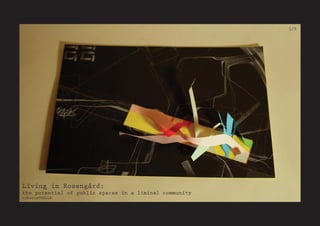2010 03 11 Model
- 1. 1/5 Living in RosengÃĨrd: the potential of public spaces in a liminal community robertoOVALLE
- 2. Concept: a new background The public experience in RosengÃĨrd is nearly absent. The ur- ban space is under-utilized as very few situations take place in it. It is also a rigid space meant for only a definite set of activities, thus neglecting countless other op- portunities of actions that could happen in it. But what happens when space works as a background for a more intense urban life? One of the characteristics to be observed from modernistic proj- ects such as RosengÃĨrd, is that very often it appears to have been planned from above. The problem with such a perspective is that even though it works in 2D or 3D, it neglects the 4th dimension. Time in architecture can be understood as how humans experience space. And acquiring experience through a span of time is often translated in de- veloping an identity. This new background aims to reinforce the vitality and intensi- ty of the events that take place in public space, making them more vis- ible and versatile, and giving more people a chance to approach and apropriate the public zones from RosengÃĨrd, their home.
- 3. 3/5
- 4. 4/5
- 5. 5/5





